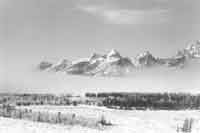Babette Mangolte, professor at the university of San Diego, defines herself as a person predominated by the two senses of eye and ear and belongs to those female artists and filmmakers who discovered cinema with the New Wave. In the 60s and early 70s she moved from France to New York and due to her interest for experimental work she became involved in the artistic scene around dance, performance, and theater. Beneath her own documentaries and feature films she especially is know for some excellent camera work like for C.Akerman‘s film Jeanne Dielman.
Rosenbaum writes on Mangolte and he gives her the credit that she subtly agrees through her own style to the mentioned confusion as no illusion.
|
Her film Sky On Location is an exploration of landscape and light, light which makes the movement enfolding through the time captured. ‘Light is a narrative device–it gives you time and it defines space’. Keeping in mind that the filmic exploration of landscape always has some relation to a political statement. |
 |
Mangolte’s film Sky On Location is a careful analysis of the american identity and history as for a certain time to be read embedded in its geography. In her credits she relates her thoughts to Babara Novak‘s Nature and Culture and one finds congruence in her way to construct a geography not based on regular mappings .
“The Sky is not about nature as backdrop, but more about the idea of wilderness, which I’ve discovered is so ingrained in American culture, but totally bewildering for Europeans. I don’t even know a French word you could use to translate the idea. I am Americanized enough now to identify with it. Traveling alone, or with one assistant, through those places helped me understand. Europe lost the sense of wilderness centuries ago. It’s so much more crowded per square mile. There is no area which is not put to some use, and which is not crossed by many roads. Even the tops of the mountains are not really secluded. And you don’t have that sense of space….”
.. an interview with Mangolte on her work can be found as pdf here.

testing